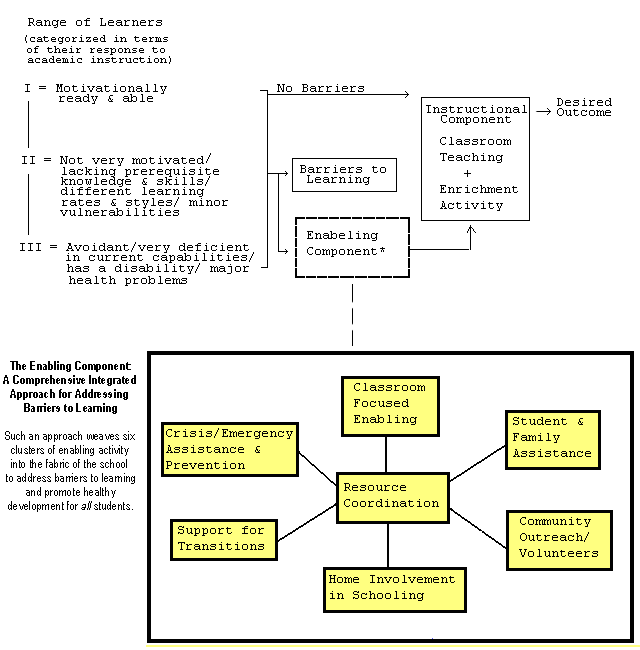

To address the needs of troubling and troubled youth, schools tend to over rely on narrowly focused and time intensive interventions. Given sparse resources, this means serving a small proportion of the many students who require assistance and doing so in a limited way. The deficiencies of prevailing approaches lead to calls for comprehensiveness -- both to better address the needs of those served and to serve greater numbers.

Some Relevant References
Adelman, H.S. (1996). Restructuring support services:Toward a comprehensive approach. Kent, OH: American School Health Association. Adelman, H.S. (1996). Restructuring education support services and integrating community resources: Beyond the full service school model. School Psychology Review, 25, 431-445. Adelman, H.S. & Taylor, L. (in press). System reform to address barriers to learning. Beyond school-linked services and full service schools. American Journal of Orthopsychiatry. Dryfoos, J.G. (1994). Full-service schools: A revolution in health and social services for children, youth, and families. San Francisco: Jossey-Bass. Knapp, M.S. (1995). How shall we study comprehensive collaborative services for children and families? Educational Researcher, 24, 5-16. Kolbe, L. (1993). An essential strategy to improve the health and education of Americans. Preventive Medicine, 22, 544-560. Taylor, L., & Adelman, H.S. (1996), Mental health in the schools: Promising directions for practice. Adolescent Medicine: State of the Art Reviews, 7, 303-317.Linking Models to Present a Unifying Approach for Policy Making | |
| CDC "components" | |
(1) Health Education |
The curricular facets of this CDC component fit into CLASSROOM-FOCUSED ENABLING. |
(2) Health Services
Fits into STUDENT AND FAMILY ASSISTANCE. | |
(3) Biophysical/ psychosocial Environments
Enhancing the environment emerges from the total programmatic effort (in all 6 areas) to address barriers to learning -- as integrated with the Instructional and Management Components at a school site. The resultant comprehensive and cohesive approach produces the type of structure that is essential for evolving and creating a healthy psychosocial and biophysical environment. | |
(4) Counseling, Psychological, & Social Services
Fits into STUDENT AND FAMILY ASSISTANCE. | |
(5) Food Services
We want to reconceptualize school breakfast and lunch services as another opportunity to offer essential programs providing SUPPORT FOR TRANSITIONS. In this respect, schools could pair breakfast time with structured before school recreation opportunities as ways to counter tardiness and enhance student readiness for the school day. The same goes for lunch and after school. Also fits in with programs related to HOME INVOLVEMENT IN SCHOOLING. | |
(6) P.E. and physical activity
Fits in SUPPORT FOR TRANSITIONS and also can play a role related to CLASSROOM-FOCUSED ENABLING and HOME INVOLVEMENT IN SCHOOLING. | |
(7) Health Programs for Faculty & Staff
In terms of providing direct health support to faculty and staff, schools will need to expand STUDENT AND FAMILY ASSISTANCE. Some of the best health benefits for faculty and staff would be related to enhancing the effectiveness of schools in Addressing Barriers to Student Learning by establishing the type of comprehensive, integrated approach called for by the Enabling Component concept. This will reduce degrees of stress and burnout. | |
(8) Integrated School/Community
COMMUNITY OUTREACH | |
School Mental Health Project-UCLA